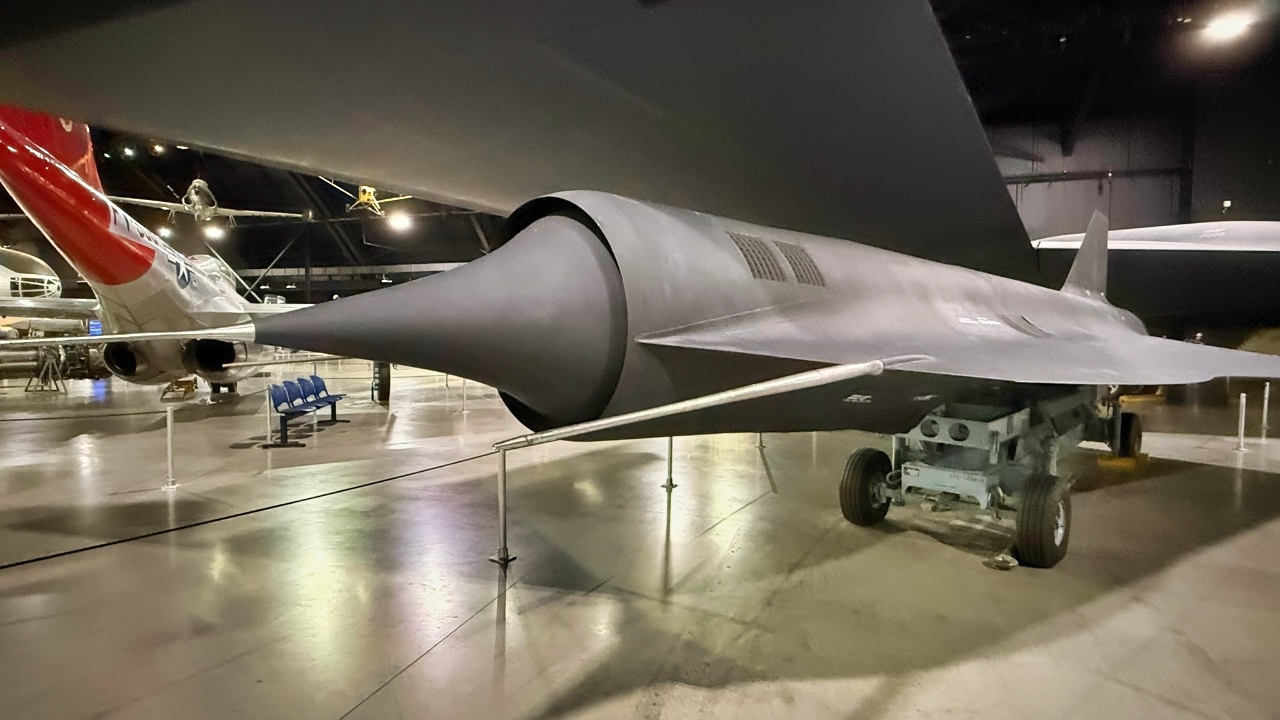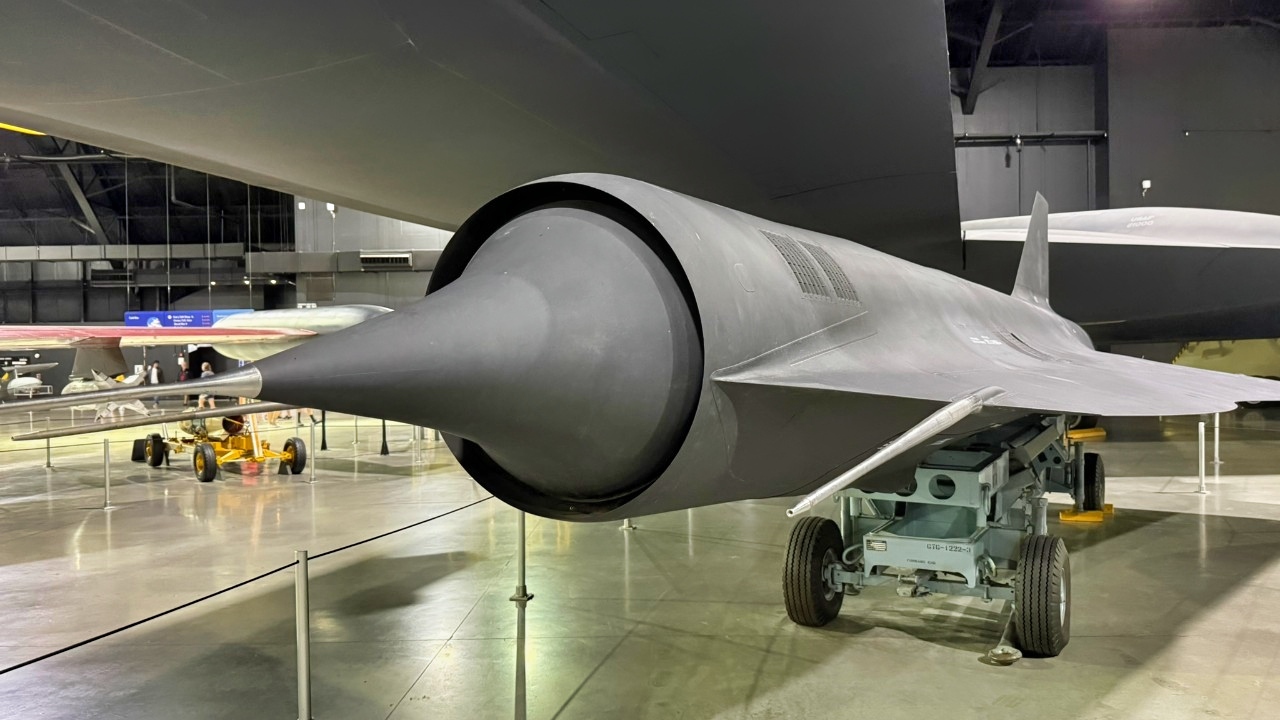Key Points and Summary on the D-21 Drone – The Lockheed D-21 was a Mach 3.3, high-altitude reconnaissance drone developed by Skunk Works in the 1960s—a revolutionary concept that was ultimately too far ahead of its time.
-Launched from the back of an A-12 Oxcart or a B-52 bomber, this ramjet-powered spy drone was designed to photograph sensitive sites, like China’s Lop Nor nuclear test facility, and eject a film canister for recovery.

Mach 3 D-21 Drone at the U.S. Air Force Museum. National Security Journal Photo Taken 7/19/2025.
-However, the program was a failure.
-Plagued by technical malfunctions and the difficulty of retrieving the film, all four of its operational missions failed before the advent of spy satellites rendered it obsolete.
-This essay includes original photos and video from a recent trip to the U.S. Air Force Museum in Dayton, Ohio, where we were inches from the D-21 drone.
Ahead of its Time: the D-21 Spy Drone
Built and designed by Lockheed’s Skunk Works division, the D-21 was a supersonic reconnaissance drone of the 1960s.
Though it could achieve blisteringly high Mach 3+ speeds, newer technology doomed the program.
The D-21 was a remarkably advanced reconnaissance drone, designed and built by Lockheed. The unmanned drone, though remarkably advanced for its era, was capable of achieving speeds greater than Mach 3.3 at an incredibly high altitude of 90,000 feet.
Leveraging its high speed and high altitude, Lockheed intended for the D-21 to penetrate enemy airspace and photograph important military installations and other targets.
Given the technology of the time, the D-21’s camera was a film camera, albeit with high resolution. After snapping its requisite photos, the drone would drop a film canister into the air, which would be retrieved and then self-destruct, unrecoverable. A parachute would slowly lower the camera’s film to the surface of the sea.
However, if the retrieval aircraft failed to nab the pod, it could, in theory, be recovered at sea in international waters by United States Navy ships.
“During a reconnaissance mission, the D-21 drone would follow a pre-programmed flight path over areas of interest. The drone would then return to international airspace, where the reconnaissance film package, equipped with its own parachute, was ejected,” the Museum of Flight explains. “The package would be recovered in mid-air by a specially equipped airplane or at sea by a ship. Shortly after the film package was jettisoned, the drone self-destructed.”

D-21 Drone. Image taken by National Security Journal on 7/19/2025.
Lockheed’s Skunk Works was also behind the A-12, a reconnaissance aircraft built for the Central Intelligence Agency and precursor platform for the SR-71 Blackbird.
Much of the A-12’s technology was incorporated into the D-21, as evident from both aircraft’s prominent chines along the fuselage, which reduce their radar cross-sections and aid lift.
The D-21’s ramjet engine was a modified version of that used by the CIM-10 Bomark, a long-range surface-to-air missile designed by Boeing. Being a ramjet-powered platform, the D-21 could initially only launch from the back of the Mach 3-capable A-12, as its engine would not function at lower speeds.
Following a fatal accident during one launch, Lockheed modified the D-21, enabling it to launch from B-52 Stratofortresses through the addition of a solid-fuel booster rocket that would accelerate the D-21 to speeds sufficient for efficient ramjet flight. These specially modified D-21s, designated D-21B, were the only variants that flew actual missions rather than test flights.
Four missions set their sights on China and the Lop Nor nuclear testing site from 1969 to 1971. All four missions failed due to either D-21B drone malfunctions or unrecovered camera pods.
In 4 Words: It Never Worked Correctly
In his 1995 book, Dark Eagles: A History of Top Secret U.S. Aircraft Programs, Curtis Peebles elaborates on the technological lead-up to the D-21 program and the factors that ultimately led to its demise.
“The D-21B Tagboard was the ultimate expression of the Black reconnaissance aircraft. The end of the D-21 program marked the end of an era in Black airplane development. The first Black airplanes, the XP-59A and P-80, had been tactical fighters. Starting in the early 1950s, the emphasis shifted to reconnaissance aircraft. The following two decades saw the X-16, U-2, Sun Tan, A-12, 147, 154, and, finally, the D-21,” Peebles writes.
Many of the D-21Bs that Skunk Works built were sent to spy on China, but the majority were lost, malfunctioned, or failed to yield actionable intelligence. But their failure was not the entire story behind the program’s termination.
“On the surface, the Tagboard program was cut short by President Nixon’s ending of China overflights. As with the Model 154, there was also a deeper reason. The cancellation of the D-21B program was not only the result of changing politics, but also a changing reconnaissance situation.” It was a situation that, at the time, was the purview of sci-fi books — books that had suddenly come to life.
“On June 15, 1971—one month before the D-21B program ended-the first Big Bird reconnaissance satellite was orbited. It was built around a large telescope and had a resolution of six inches from over 100 miles high. Improved Big Birds would operate for as long as 275 days. Johnson had long realized the effect satellites would have. In 1959, when the A-12 project was just getting started, he asked the CIA whether there would be one round of aircraft development or two before the satellites took over. Both agreed there would be only one. This proved accurate—while the SR-71 served for a quarter of a century, the A-12 and D-21 both had brief operational lives.”
Postscript on D-21 Drone
The finicky nature of the D-21 and the difficulty inherent in the film recovery process, as well as the high-tech drone’s single-use, disposable nature, doomed the program.
More like a speeding missile than a drone, the D-21 was highly innovative for its time, but could not compete with spy satellites in terms of cost and overhead persistence.
About the Author: Caleb Larson
Caleb Larson is an American multiformat journalist based in Berlin, Germany. His work covers the intersection of conflict and society, focusing on American foreign policy and European security. He has reported from Germany, Russia, and the United States. Most recently, he covered the war in Ukraine, reporting extensively on the war’s shifting battle lines from Donbas and writing on the war’s civilian and humanitarian toll. Previously, he worked as a Defense Reporter for POLITICO Europe. You can follow his latest work on X.











Pingback: The B-21 Raider Stealth Bomber's Biggest Success in 3 Words - National Security Journal
David Charles LaFranchise
November 13, 2025 at 1:03 pm
Why not a few words on the actual missions if there were only 4?